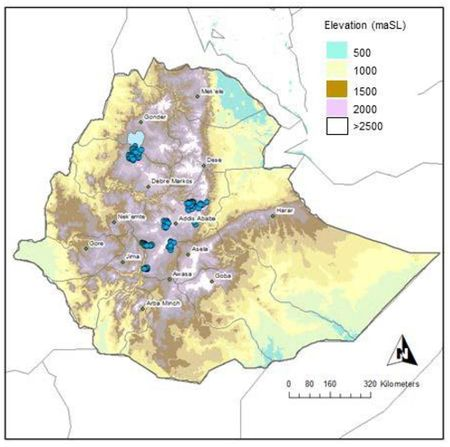OR/17/024 Survey 1, Ethiopia
| Kebede, S, MacDonald, A M, Bonsor, H C, Dessie, N, Yehualaeshet, T, Wolde, G, Wilson, P, Whaley, L, and Lark, R M. 2017. UPGro Hidden Crisis Research Consortium — Survey 1 Country Report–Uganda . British Geological Survey Internal Report, OR/17/024. |
 |
Survey 1 in Ethiopia was conducted from 9 April to 20 June in 2016. A total of 172 boreholes across nine woredas within three regions: Oromia (Abichugna, Ejere), Southern Nations and Nationalities (Soro, Abeshege, Sodo) and Amhara, (SayaDebrina, Basona Worena, Bahir dar and Mecha) — Figure 2. Physical characteristics of the woredas included in Survey 1 are summarised in Table 1.
Site selection. The water points in Survey 1 were chosen by a stratified two-stage random sampling design. The domain to be sampled comprised those Woredas over igneous aquifers (the main aquifer type in the country) where sampling was deemed practicable by WaterAid. There are 404 Woredas over igneous aquifers, covering much of the Ethiopian Highlands. Of these, 98 were regarded as feasible to sample, and these constitute the sampling domain. Woredas were used as primary sample units and were randomly chosen from within each of four strata defined with respect to hydrogeology (fractured or porous igneous rocks) and poverty (above or below Ethiopian median). Water points were then randomly chosen from within each Woreda selected in the primary sampling phase. Only boreholes equipped with handpumps were considered.
The relative size of each stratum was computed from the numbers of shallow water points recorded in the national WASH inventory. To account for differences between the 98 Woredas in the sampling domain and all 404 Woredas within igneous aquifers, the results presented below are computed from stratum sample means and the relative size of the strata over all igneous aquifers. Treating these as an estimate for this entire domain, as opposed to the original domain of Woredas available for sampling, assumes that Woredas within any stratum of the sample domain are representative of that stratum over the aquifer as a whole.
Survey methods. At each hand-pump equipped borehole (HPBs) field tests were used to assess water quality, microbiology, yield of the supply, users perception of the HPB functionality performance, and the experience and capacity of community management arrangements.
Survey team. The Survey Team in Ethiopia was led by Addis Ababa University, and was supported by: BGS and Sheffield University in the UK; WaterAid Ethiopia, who played a key part in facilitating the fieldwork; and Woreda Water Bureaus, who helped facilitate access to communities, and assisted the survey team.

| District | Regional state |
Distance from Addis Ababa (km) |
Av. Elevation (mamsl) |
Mean annual rainfall (mm) |
Mean annual temp. (°C) |
Dry months |
| Abichugna | Oromia | 140 | 2700 | 980 | 14.4 | Oct–May |
| Ejere | Oromia | 45 | 2300 | 1190 | 16.4 | Oct–Feb |
| Soro | SNNP | 262 | 2050 | 1200 | 16.5 | Nov–Feb |
| Abeshege | SNNP | 190 | 1700 | 1264 | 17.7 | Oct–Mar |
| Sodo | SNNP | 110 | 2000 | 1060 | 17.2 | Oct–Feb |
| Seya Debrina | Amhara | 165 | 2650 | 980 | 18.8 | Oct–May |
| Basona Worena | Amhara | 120 | 2785 | 1190 | 16.4 | Oct–Mar |
| Bahir Dar | Amhara | 550 | 1860 | 1450 | 20 | Nov–Apr |
| Mecha | Amhara | 525 | 2005 | 1452 | 20 | Nov–Apr |